 Fig 1: Iraqi crude exports by SOMO
Fig 1: Iraqi crude exports by SOMO
The above graph shows Iraqi crude oil exports by the SOMO oil marketing company. Until March 2014 Kirkuk crude from North Oil Company (Avana and Baba domes and Bai Hassan fields) was flowing through the Iraq-Turkey pipeline (ITP) Kirkuk – Baiji refinery – Faysh Khabur (capacity 600 kb/d, metering station under Baghdad control near the border with Turkey) and on to the Ceyhan terminal in Southern Turkey. It stopped operating due to frequent attacks by militants. In June 2014 ISIL attacked the Baiji refinery (230 kb/d) and heavy fighting started with the Iraqi army.
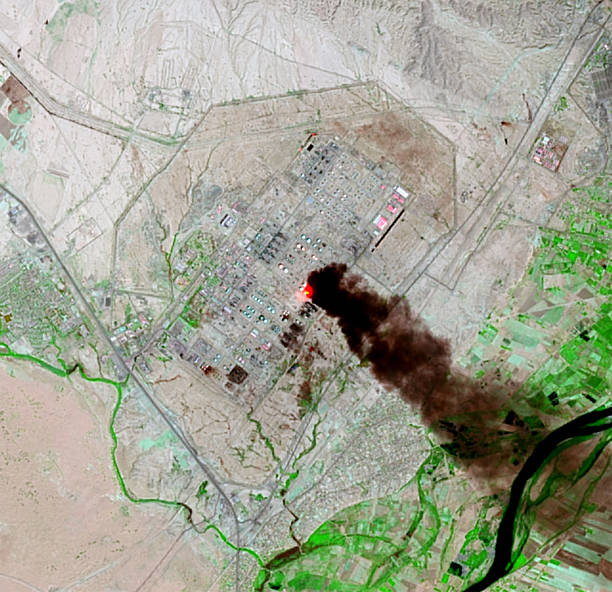 Fig 2: Baiji refinery in September 2014
Fig 2: Baiji refinery in September 2014
The refinery changed hands several times and was finally retaken by the Iraqi army in Nov 2015 but it was badly damaged.
The Kurdish Government built their own pipeline infrastructure with following capacities
- Tawke oil field to Faysh Khabur (250 kb/d)
- Taq Taq oil field to Khurmala, the northern dome of the Kirkuk oil field (150 kb/d)
- Khurmala to Faysh Khabur (700 kb/d)
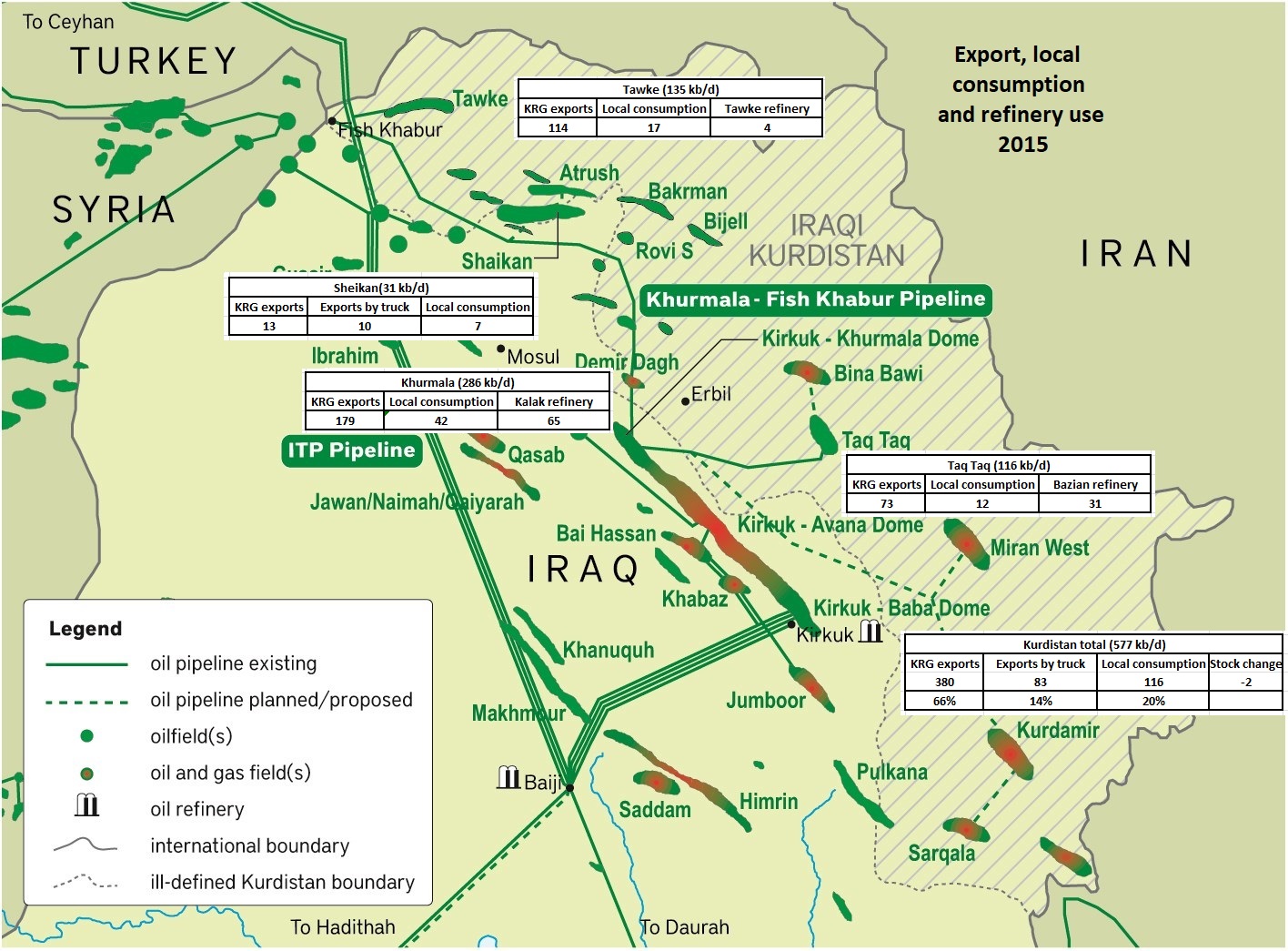 Fig 3: Northern Iraq’s oil field and pipeline map and KRG’s oil production 2015
Fig 3: Northern Iraq’s oil field and pipeline map and KRG’s oil production 2015
The map is from here:
The oil data are from the KRG government
Projects (a) – (c) were completed by end 2013. Another pipeline between Khurmala and Avana was built and opened in mid 2014. This allowed Kirkuk oil to be exported via the KRG pipeline.
In December 2014 an agreement was made between Baghdad and KRG with following provisions:
(1) the KRG give 250,000 b/d of the crude oil produced in its territory to SOMO at the Ceyhan terminal to market the crude,
(2) Iraq (Baghdad) export 300,000 b/d of Kirkuk crude through KRG’s pipeline to Ceyhan
(3) Iraq (Baghdad) resume federal payments to the KRG that will amount to a 17% share of Iraq’s federal budget and pay KRG’s Peshmerga military forces $1 billion.
The deal was intended to allow SOMO to reclaim marketing control over much of Iraq’s northern crude exports. This brought about the 2nd Kirkuk export spike in Fig 2. But the deal lasted only until mid 2015 because KRG received less than 17% of Baghdad’s budget. We can see this clearly in the next graph:
 Fig 4: Allocation of KRG exports
Fig 4: Allocation of KRG exports
https://www.oxfordenergy.org/wpcms/wp-content/uploads/2016/10/Can-Iraqi-oil-production-surprise-again-on-the-upside.pdf
Let’s have a look at production by field
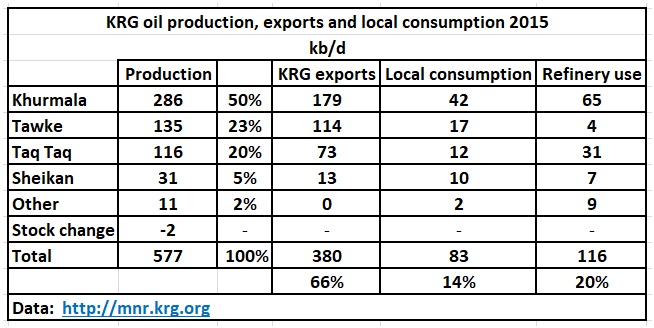 Fig 5: KRG oil production, exports, local consumption and refinery use in 2015
Fig 5: KRG oil production, exports, local consumption and refinery use in 2015
http://mnr.krg.org/images/monthlyreports/KRG_MNR_Full_Annual_Report_2015_2.pdf
Khurmala in the above table includes production from Kirkuk (Avana Dome and Bai Hassan field) after KRG’s Peshmerga took control of these fields when the Iraqi Army fled from ISIL in 2014. The KAR Group then operated these fields which were previously run by the federal Iraqi North Oil Company (NOC). In October 2017 the Iraqi army took again control over NOC fields.
Let’s have a look how production developed over time:
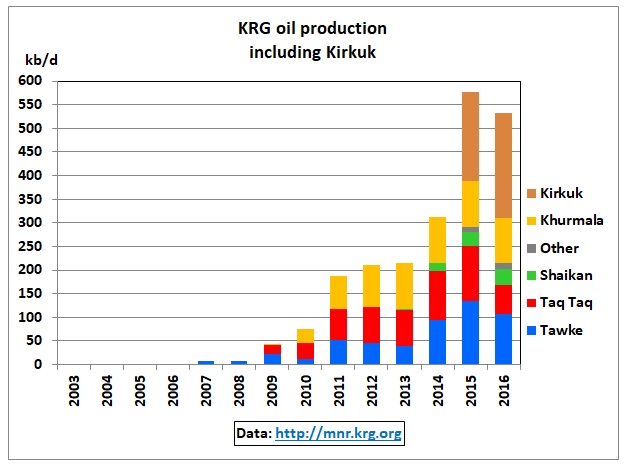 Fig 6: KRG and Kirkuk oil production
Fig 6: KRG and Kirkuk oil production
We see that the KRG fields peaked in 2015.
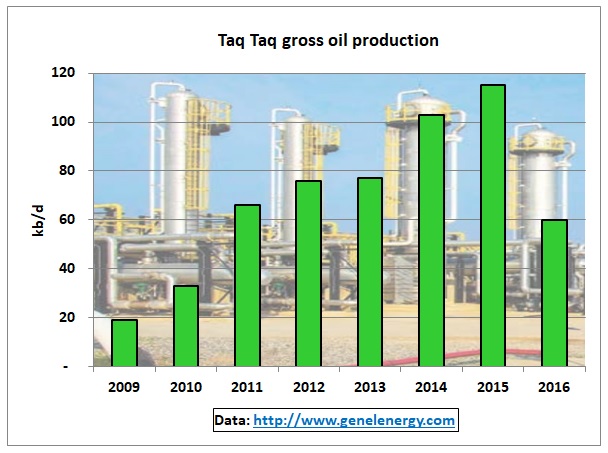 Fig 7: Taq Taq gross oil production
Fig 7: Taq Taq gross oil production
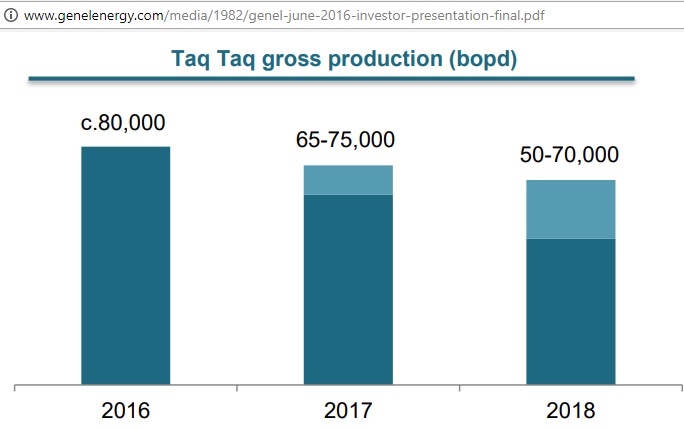
Fig 8: Taq Taq projected production in 2016 investor presentation
http://www.genelenergy.com/media/1982/genel-june-2016-investor-presentation-final.pdf
Production for 2017 was not 65-75 kb/d but it dropped to 19 kb/d in March 2017:
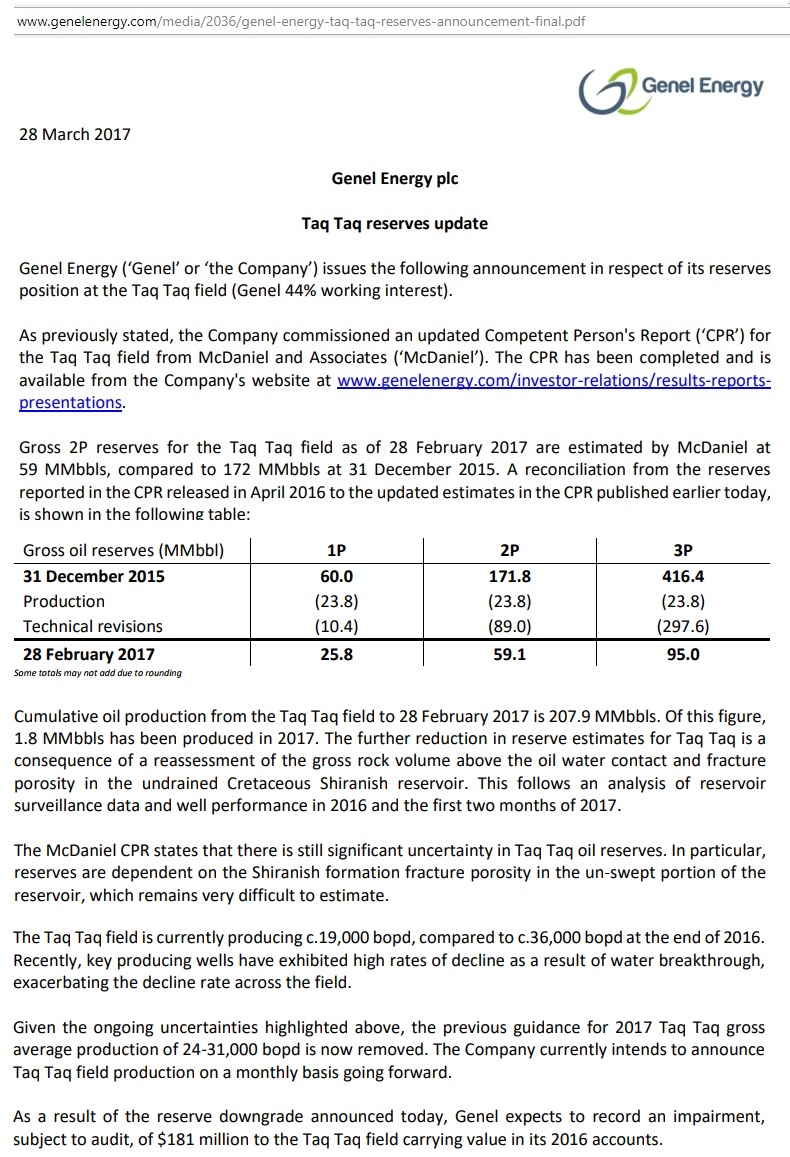 Fig 9: Taq Taq reserves
Fig 9: Taq Taq reserves
http://www.genelenergy.com/media/2036/genel-energy-taq-taq-reserves-announcement-final.pdf
Genel Energy another victim of Kurdish geology
16/4/2017
“Genel Energy, launched by the former BP boss Tony Hayward in 2011, cut its reserves at the flagship Taq Taq field, up in the Kurdish mountains, from 499 million barrels to 172 million barrels in 2016, then on March 28 again to 59 million barrels. Taq Taq production has tumbled from 116,000 barrels per day to 19,000 bpd.
The reservoir rocks are highly fractured, allowing wells to drain oil rapidly through the cracks. But the small pores in the reservoir rock matrix here, which hold the bulk of the oil in typical fields, are not contributing to production at all. Once the relatively small volume of oil in the fractures is drained, they fill with water.”
https://www.thenational.ae/business/genel-energy-another-victim-of-kurdish-geology-1.21278
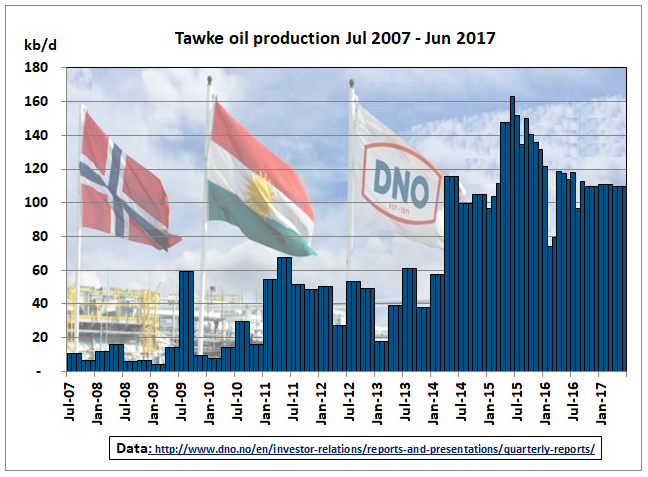 Fig 10: Tawke oil production
Fig 10: Tawke oil production
http://www.dno.no/en/investor-relations/reports-and-presentations/quarterly-reports/
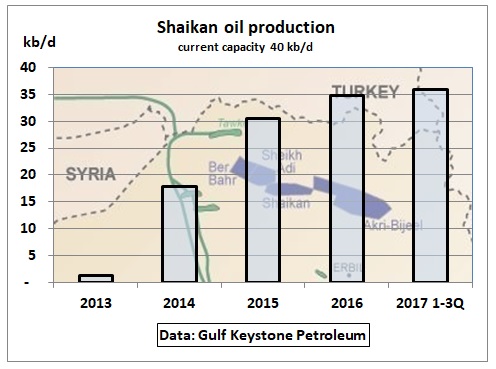 Fig 11: Shaikan oil production
Fig 11: Shaikan oil production
http://www.gulfkeystone.com/
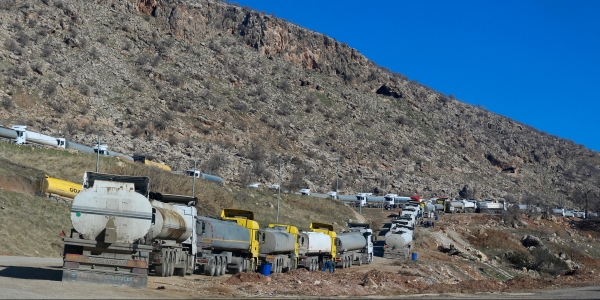 Fig 12: Skaikan oil is trucked to Turkey
Fig 12: Skaikan oil is trucked to Turkey
http://www.iraqoilreport.com/news/trucker-strike-risks-output-kurdistans-shaikan-field-19426/
Kirkuk
It is parroted 1,000 times: Kirkuk is an oil rich region. Well, it was. Let’s have a look at the numbers
The geological Kirkuk field consists of 3 domes
Khurmala North Dome (within KRG, operated by KAR since 2009 – see Fig 6),
Avana Dome
Baba Dome
The Bai Hassan field is nearby and connected by pipeline to Kirkuk
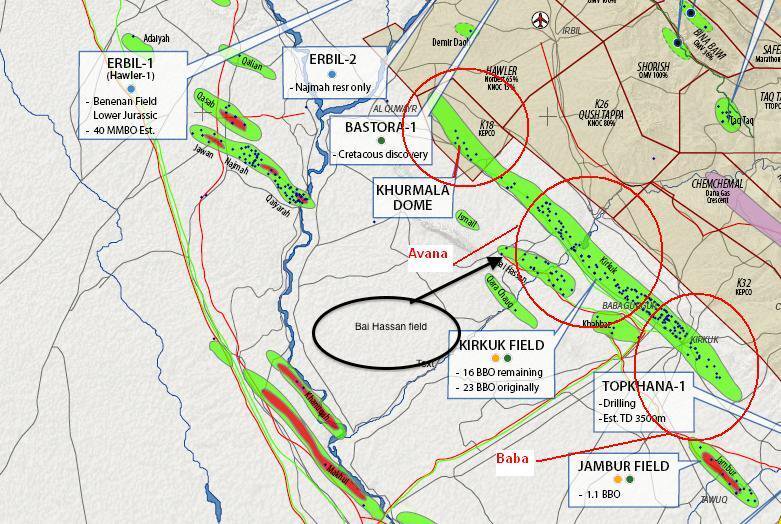 Fig 13: Kirkuk’s 3 domes
Fig 13: Kirkuk’s 3 domes
http://ekurd.net/mismas/articles/misc2012/3/state6034.htm
Having been discovered in 1927 in Baba Gargur by the Turkish Petroleum Company (renamed in 1929 to Iraq Petroleum Company, IPC), with production starting in 1934, Kirkuk is an aging oil field.
Data on historic production are hard to come by.
1938 28 kb/d Country studies
According to the Iraq oil Almanac, Kirkuk produced
1950 120 kb/d
1954 360 kb/d (exports to Baniyas in Syria)
1956 600 kb/d
1960 800 kb/d
For March 1973, the year of the 1st oil crisis, a CIA report mentions following production figures (but no annual average given):
Kirkuk (and other northern fields) 1,274 kb/d (exports via pipeline to Banias, Syria)
North Rumaila 108 kb/d
Rumaila and Zubair 648 kb/d
Other 16 kb/d
Total 2,046 kb/d
https://www.cia.gov/library/readingroom/docs/CIA-RDP85T00875R001700050047-4.pdf
In 1975 Iraqi oil production by International Oil Companies was fully nationalised, a process which had started with Law 80 in 1961.
A turbulent production history follows for all of Iraqi oil fields and therefore also Kirkuk, marked by the Iran-Iraq war, Desert Storm, UN sanctions and finally the Iraq war as shown in the following graph:
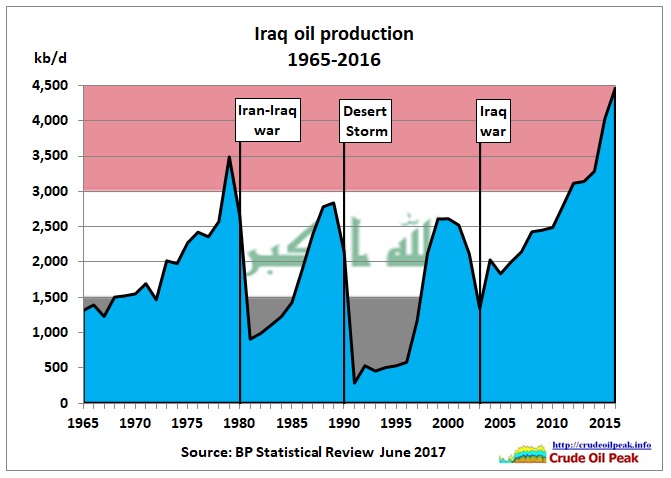 Fig 14: Iraq’s discontinuous oil production
Fig 14: Iraq’s discontinuous oil production
In March 2000, a Report of the group of UN experts established pursuant to paragraph 30 of the Security Council resolution 1284 (2000) about the impact of the Oil-for-Food program on the Iraqi oil industry in the northern region found following production capacity (not necessarily production):
KIRKUK 755 kb/d
BAI HASSAN 95 kb/d
JAMBUR 45 kb/d
KHABAZ 5 kb/d
The report noted the desolate state of affairs:
The “Oil-for-Food” spares program has failed to establish and support a sustainable oil production system in the North. Apart from the successful delivery of de-watering chemicals to treat wet crude, and bactericide to treat injection water, the impression received was “too little, too late” with regard to the supply of essential items.
It should also be noted that the water-injection program for Kirkuk Field reached a point of critical balance during the last few months and contributed significantly to the trends described. With an oil-column of only 30 to 50 metres remaining in Avanah and Baba Domes, and a re-pressured common aquifer, the injection program needs very careful control to prevent water breakthrough along the fracture system in the limestone reservoir. With no telemetry, nor operational communications, nor adequate water-treatment spares, the possibility of irreversible damage to the reservoir of this super-giant field is now imminent.
http://www.un.org/Depts/oip/background/reports/oilexpertsreport.pdf
In the last years of the Oil-for-Food program exports from Kirkuk to Turkey were:
2001 530 kb/d average although in the 2nd half of 2001 it was 910 kb/d
2002 520 Kb/d
2003 660 Kb/d (Jan – Feb 2003 before the Iraq war)
2011 290 kb/d reported by Iraqi Extractive Industries Transparency Initiative
https://eiti.org/sites/default/files/documents/2011_iraq_eiti_report.pdf
2012 270 kb/d reported by IEA in the WEO 2012
https://www.iea.org/publications/freepublications/publication/WEO_2012_Iraq_Energy_OutlookFINAL.pdf
2015 280 kb/d reported by FGEnergy
2016 320 kb/d reported by FGEnergy
 Fig 15: KRG and Kirkuk oil production by field
Fig 15: KRG and Kirkuk oil production by field
https://www.fgenergy.com/media/477073/e8befb0b-90de-445f-b40b-b3aebb467545.pdf
The above numbers give only a rough idea and they may be inconsistent. Jean Laherrere from ASPO France kindly provided data from Rystad.
 Fig 16: Kirkuk oil production comparison Rystad vs Hubbert curve
Fig 16: Kirkuk oil production comparison Rystad vs Hubbert curve
The above graph has nothing to do with modelling. It simply compares actual production (red) with a hypothetical Hubbert production curve (blue) using following input parameters:
Pm (maximum production) 584 mb pa (1,600 kb/d)
Tm (year of maximum production) 50 years (i.e lifespan 100 years)
U (ultimate recovery) 23 Gb
The formulas are here: http://dieoff.org/page191.htm
The ultimate was taken from IEA’s World Energy Outlook 2012
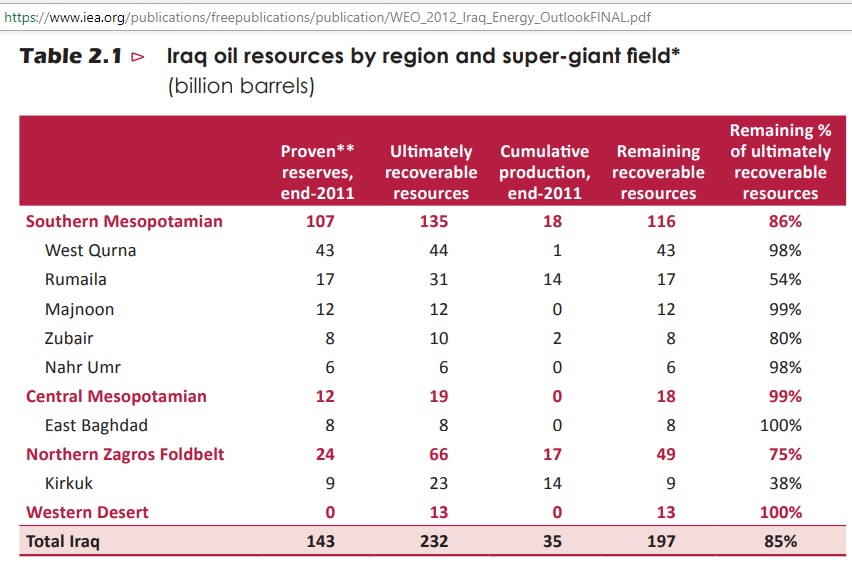
Fig 17: Iraq’s oil reserves in IEA’s WEO 2012
The Hubbert curve assumes:
(a) Smooth investment path for development of all oil fields
(b) Continuous production
(c) No government interference
(d) No pipeline problems/limitations
(e) Functioning oil markets
(f) No civil unrest or wars
In the case of Iraq, none of these conditions was met. Nevertheless, it is interesting to note that actual production more or less remained within the Hubbert curve envelope. Cumulative production at end 2016 was 16.5 Gb. Compared with an ultimate of 23 Gb that is a depletion level of 72%. Due to the uncertainty in data this is an approximate percentage. But it should be clear that Kirkuk is a mature oil field in the last stage of its productive life.
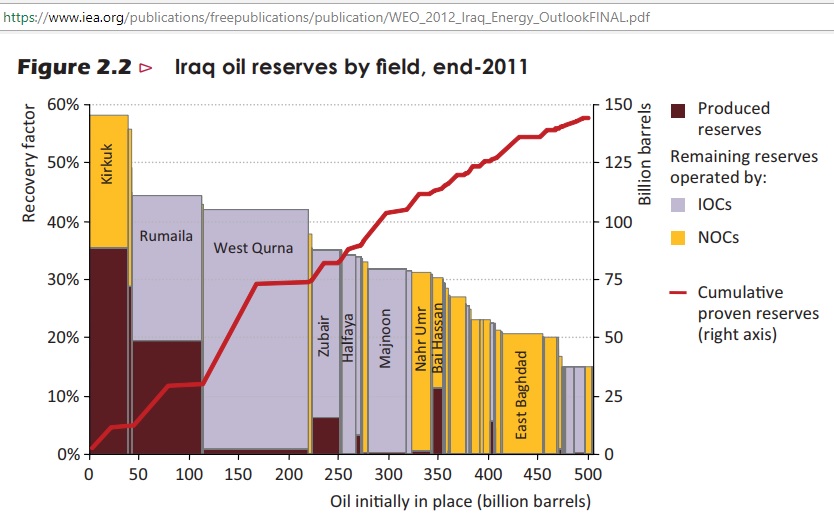
Fig 18: Recovery factors and produced reserves in Iraqi oil fields
We can see that Kirkuk has the highest depletion level among all fields and that most of Iraq’s oil elsewhere is still to be produced.
Fig 16 suggests that Kirkuk oil which was not produced in the past due to all these interruptions will now be produced in future. Due to re-injection of heavier crude oil fractions and other disruptions the remaining Kirkuk oil will not be easy to produce.
After Iraqi troops recaptured Kirkuk in October 2017, the Iraqi government asked BP to help rehabilitating Kirkuk’s oil field.
24/10/2017
The oil minister discussed reactivating a deal signed in 2013 with BP to revive Iraq’s northern Kirkuk oilfield and help Baghdad arrest a huge decline in output from Kirkuk and increase production to higher levels, said Jihad.
But in 2013 it was already clear what challenge that will be:
Iraqi officials have said they would like BP to raise production capacity to around 600,000 bpd in five years.
But the pace of development at Kirkuk will be slower than at the giant southern fields of Rumaila, Zubair and West Qurna-1 where BP, Eni and Exxon have helped to raise output by 600,000 bpd in just two years.
“There will be no radical development,” said the industry source. “This is an old, big field that’s in decline and needs a lot of attention.”
Conclusion:
And what needs attention of course is how the future relationship between the KRG government and Baghdad will develop. Points of conflict will be the metering station Faysh Khabur, the Khurmala oil field (Kirkuk North Dome) and the use of the KRG pipeline for Kirkuk oil as long as the ITP is not in operation
Related posts:
30/10/2015
Iraq needs 1.3 mb/d additional oil exports and $70 oil to balance budget
http://crudeoilpeak.info/iraq-needs-1-3-mbd-additional-oil-exports-and-us-70-oil-to-balance-budget
15/6/2014
World’s untested assumption on 6 mb/d of Iraqi oil by 2020
http://crudeoilpeak.info/worlds-untested-assumption-on-6-mbd-iraqi-oil-by-2020
9/8/2013
Iraq crude oil exports stall amid pipeline attacks
http://crudeoilpeak.info/iraq-crude-oil-exports-stall-amid-pipeline-attacks
16/3/2013
Iraq war and its aftermath failed to stop the beginning of peak oil in 2005
http://crudeoilpeak.info/iraq-war-and-its-aftermath-failed-to-stop-the-beginning-of-peak-oil-in-2005